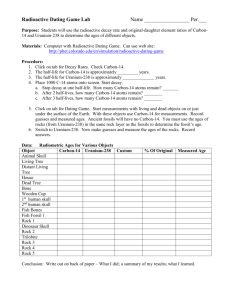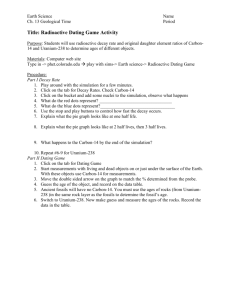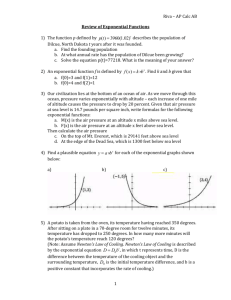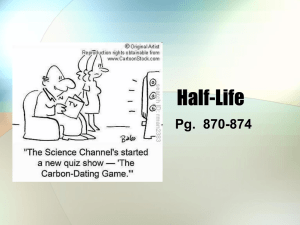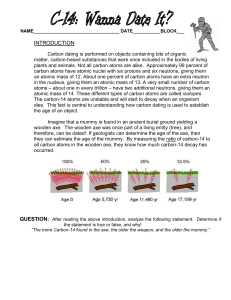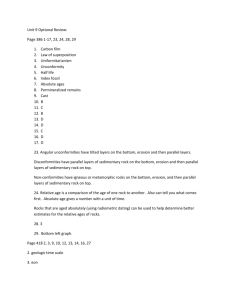How Carbon-14 is Made
advertisement
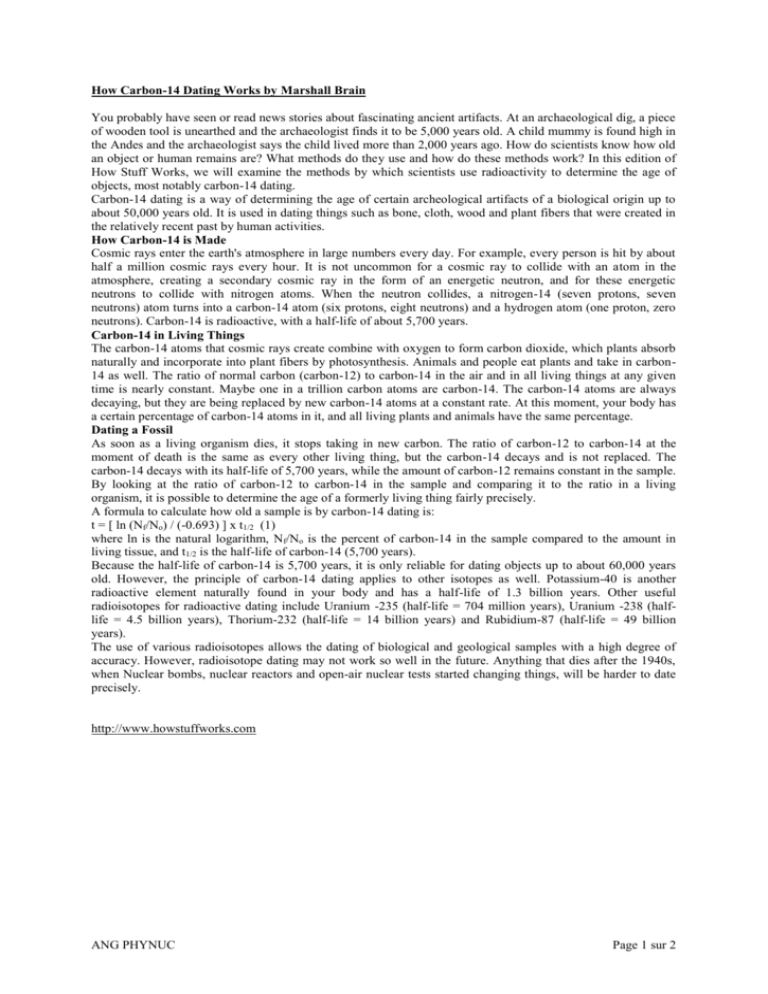
How Carbon-14 Dating Works by Marshall Brain You probably have seen or read news stories about fascinating ancient artifacts. At an archaeological dig, a piece of wooden tool is unearthed and the archaeologist finds it to be 5,000 years old. A child mummy is found high in the Andes and the archaeologist says the child lived more than 2,000 years ago. How do scientists know how old an object or human remains are? What methods do they use and how do these methods work? In this edition of How Stuff Works, we will examine the methods by which scientists use radioactivity to determine the age of objects, most notably carbon-14 dating. Carbon-14 dating is a way of determining the age of certain archeological artifacts of a biological origin up to about 50,000 years old. It is used in dating things such as bone, cloth, wood and plant fibers that were created in the relatively recent past by human activities. How Carbon-14 is Made Cosmic rays enter the earth's atmosphere in large numbers every day. For example, every person is hit by about half a million cosmic rays every hour. It is not uncommon for a cosmic ray to collide with an atom in the atmosphere, creating a secondary cosmic ray in the form of an energetic neutron, and for these energetic neutrons to collide with nitrogen atoms. When the neutron collides, a nitrogen-14 (seven protons, seven neutrons) atom turns into a carbon-14 atom (six protons, eight neutrons) and a hydrogen atom (one proton, zero neutrons). Carbon-14 is radioactive, with a half-life of about 5,700 years. Carbon-14 in Living Things The carbon-14 atoms that cosmic rays create combine with oxygen to form carbon dioxide, which plants absorb naturally and incorporate into plant fibers by photosynthesis. Animals and people eat plants and take in carbon14 as well. The ratio of normal carbon (carbon-12) to carbon-14 in the air and in all living things at any given time is nearly constant. Maybe one in a trillion carbon atoms are carbon-14. The carbon-14 atoms are always decaying, but they are being replaced by new carbon-14 atoms at a constant rate. At this moment, your body has a certain percentage of carbon-14 atoms in it, and all living plants and animals have the same percentage. Dating a Fossil As soon as a living organism dies, it stops taking in new carbon. The ratio of carbon-12 to carbon-14 at the moment of death is the same as every other living thing, but the carbon-14 decays and is not replaced. The carbon-14 decays with its half-life of 5,700 years, while the amount of carbon-12 remains constant in the sample. By looking at the ratio of carbon-12 to carbon-14 in the sample and comparing it to the ratio in a living organism, it is possible to determine the age of a formerly living thing fairly precisely. A formula to calculate how old a sample is by carbon-14 dating is: t = [ ln (Nf/No) / (-0.693) ] x t1/2 (1) where ln is the natural logarithm, Nf/No is the percent of carbon-14 in the sample compared to the amount in living tissue, and t1/2 is the half-life of carbon-14 (5,700 years). Because the half-life of carbon-14 is 5,700 years, it is only reliable for dating objects up to about 60,000 years old. However, the principle of carbon-14 dating applies to other isotopes as well. Potassium-40 is another radioactive element naturally found in your body and has a half-life of 1.3 billion years. Other useful radioisotopes for radioactive dating include Uranium -235 (half-life = 704 million years), Uranium -238 (halflife = 4.5 billion years), Thorium-232 (half-life = 14 billion years) and Rubidium-87 (half-life = 49 billion years). The use of various radioisotopes allows the dating of biological and geological samples with a high degree of accuracy. However, radioisotope dating may not work so well in the future. Anything that dies after the 1940s, when Nuclear bombs, nuclear reactors and open-air nuclear tests started changing things, will be harder to date precisely. http://www.howstuffworks.com ANG PHYNUC Page 1 sur 2 Questions : 1) In your own words explain the process of carbon-14 dating described in the article. 2) What does the 14 mean in the phrase : “carbon-14”? 3) The carbon-14 half-life is 5700 years. Define “half-life”. 4) Where does the figure 0.693 in formula (1) come from? 5) Use formula (1) to calculate the age of a fossil that had 10 percent carbon-14 compared with a living sample. 6) Balance the equation of the carbon decay into nitrogen : 14 6C 14 7N + ? 7) What sort of particle is produced by this decay ? What is this decay called? 8) Compare the different types of radiation from radioactive nuclei, the health hazard associated and the means of protection. ANG PHYNUC Page 2 sur 2

